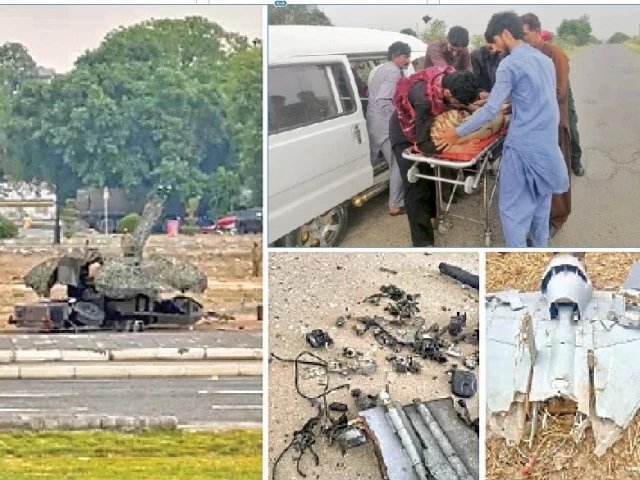30 Indian kamikaze drones downed
Israeli-made UAVs taken down across multiple cities; Two martyred in Pindi, one each in Attock, Ghotki districts

The Pakistan army intercepted and destroyed 30 Israeli-made Herop drones, sent by India to target civilian and military installations on Thursday, as the army soldiers inflicted heavy losses on the enemy at different locations on the Line of Control (LoC) in Kashmir.
The downed drones were detected over multiple cities, including Rawalpindi, Gujrat, Attock, Gujranwala, Lahore, Sheikhupura, Nankana, Ghotki and Karachi's Malir district, the Inter-Services Public Relations (ISPR) said.
On the LoC, security sources said, Pakistani troops effectively responded to the Indian army's unprovoked firing in the Pando sector, destroying their battalion headquarters in Nanga Tak and inflicting heavy losses on them elsewhere.
Loud explosions were heard in several of areas as Pakistan's air defence systems engaged the intruding drones. An ISPR official said that it was for the first time ever that this Israeli unmanned aerial vehicle (UAV) – Heron MK 2s, which flies at altitudes as high as 35,000 feet – was neutralised during combat.
The military confirmed that the drones were of Israeli origin and had engines manufactured by Britain's UAV Engines Ltd. The ISPR attributed India's drone aggression to her "desperation" following Pakistan's strong response to its strikes on Wednesday and its losses of aircraft, drones and border posts.
"These cowardly attacks reflected New Delhi's panic and strategic disarray," the military stated, adding that the Indian forces also suffered substantial damage along the Line of Control (LoC). The wreckage of the drones is being recovered from affected regions.
Deaths and damages
"The Pakistan Army is giving a forceful and calculated response, dismantling all enemy designs," the ISPR said, adding that all intruding drones had been neutralised, using a combination of soft-kill [technical] and hard-kill [weapons-based] countermeasures.
In Lahore, however, there were injuries to four soldiers and minor damage to military assets, as the drones attempted incursions near Walton Old Airport and Burki. The local residents poured into the streets because of the attempted strikes near sensitive areas.
The debris was recovered from near Jallo Park, which has since been sealed off. Police and elite force units have secured the area. Meanwhile, authorities clarified that explosions heard in Walton and other areas were part of mock exercises, and residents were urged to stay indoors.
Elsewhere, in Walton and Sheikhupura, drones fell into agricultural fields, reportedly injuring several civilians. In Gujranwala, two explosions were heard on Thursday morning, triggering the activation of air defence systems in the Cantt area. One drone was taken down.
Two civilians were martyred and one was injured in Rawalpindi and Attock, where drones crashed in urban and semi-rural areas. In Rawalpindi, debris fell on a shop near Stadium Road's food street, shattering windows and injuring Tauqir Shah and Haider Ali.
Haider, a contractor hired by stadium authorities, succumbed to his wounds at Benazir Bhutto Hospital. All gates of the Rawalpindi Cricket Stadium were shut, and security personnel cordoned off the area, witnesses said. Another drone fell near the Race Course Ground, damaging a residential building.
Similarly, in Gujrat, drone wreckage was found in Pir Jhand village. In Nankana and Sheikhupura, additional drones were downed, and debris landed in open fields. In Attock's Jabi Khasran area, 65-year-old Mahboob Elahi was martyred, after sustaining injuries from a falling drone in his fields.
In Sindh, Mukhtiar Ahmed was martyred, and another villager was injured due to a drone strike in Sarfaraz Laghari village of the Ghotki district. In Sharafi Goth in Malir district of Karachi, a drone was shot down, and the area was cordoned off by police.
A false report of a drone strike near Faisal Mosque was also dismissed by Islamabad deputy commissioner Irfan Nawaz Memon, who warned of fake sirens and misinformation campaigns causing unnecessary panic.
Authorities across Islamabad, Lahore and Karachi urged citizens to refrain from spreading or trusting unverified news. "Only rely on official statements made through credible government channels," officials urged.
The ISPR said that Indian drones were also neutralised in Chakwal, Bahawalpur, Miano, Chhor and other areas. Drone strikes come on the second day of major clashes between the nuclear-armed neighbours. Defence Minister Khawaja Asif warned that Pakistan's response was "increasingly certain".
"The escalation follows India's cowardly assault on May 6/7, which resulted in the destruction of five advanced aircraft, drones, multiple military posts, and casualties among Indian troops," said the ISPR news release.
"In a state of panic and confusion, India has resorted to deploying Israeli-made Harop drones for attacks on Pakistani territory. These unprovoked attacks are a clear reflection of India's desperation and frustration, as it continues to suffer significant losses along the LoC."
Pakistan's retaliation "is increasingly becoming certain now," the defence minister told Reuters. "I will still refrain from saying it is 100%. But the situation has become very difficult. We have to respond," he added.
What is Harop?
According to a Times of Israel report, the Harop, manufactured by Israel Aerospace Industries, is a loitering munition that can fly to targets and then attack by crashing into them on command from the operator, destroying itself in the process.
The Harop is equipped with electro-optical (EO), infrared (IR), and forward-looking infrared (FLIR) sensors, as well as a colour CCD camera and anti-radar homing capabilities, providing target detection and identification, says a Eurasian Times report.
It further states that Harop can seek targets in a designated area for nine hours, locate and identify them, plan an attack route, and then pursue the strike from any direction at shallow or steep dive angles. Due to its immunity to GNSS jamming, Harop overcomes communication challenges.
Launched from canisters mounted on trucks or naval vessels, Harop is easily deployed from diverse terrains and environments. The drone will return to the base if a target is not engaged. It has been designed to minimise its radar signature through stealth (low observability).
Why India used Harop?
According to Pakistani security sources, the Indian Air Force (IAF) might be hesitant to launch further manned air missions after losing five of its warplanes in the air combat with PAF on the night between May 6 and 7.
They further said that India was trying to divert attention from its military setbacks with such provocative actions to appease the domestic audience. The military said that it remained on high alert, responding to each act of aggression with a "firm and proportionate" approach.
It was a huge embarrassment for India when it launched a missile strike on Pakistan but lost five of its jets, including three modern Rafale aircraft, in air combat during the retaliation from the PAF. New Delhi hasn't officially confirmed the downing of Rafale jets.
However, a senior French intelligence official confirmed to CNN that one Rafale jet had indeed been shot down by Pakistan, marking the first time one of these advanced French aircraft had been lost in combat.
An American commentator on CNN remarked that the potential loss of Rafale jets would deal a significant blow to India's claim of air superiority, which it had built around the induction of these French-made warplanes.
Some experts suggested that the confrontation between the two countries served as a test of both Chinese and Western military technologies, particularly after Pakistan's acquisition of J-10C jets from China in response to India's Rafale fleet. Analysts have noted that China's J-10C jets are proving to be highly effective, potentially shifting the regional balance of power.





















COMMENTS
Comments are moderated and generally will be posted if they are on-topic and not abusive.
For more information, please see our Comments FAQ